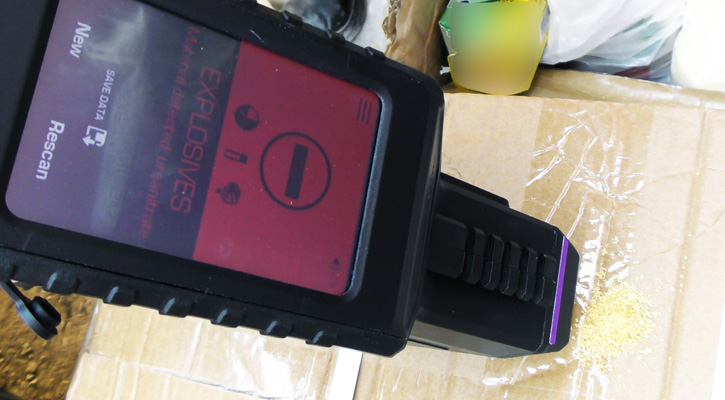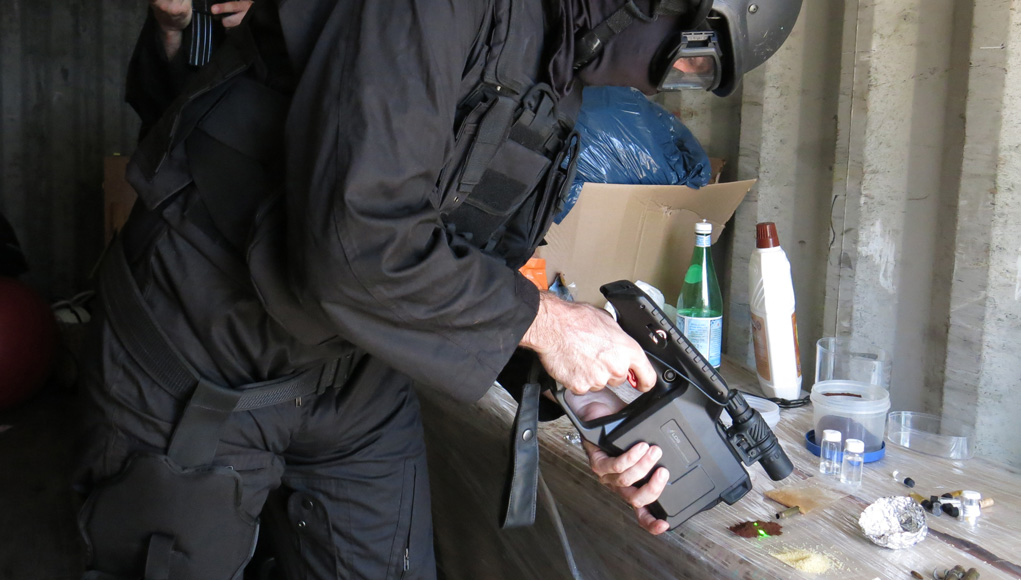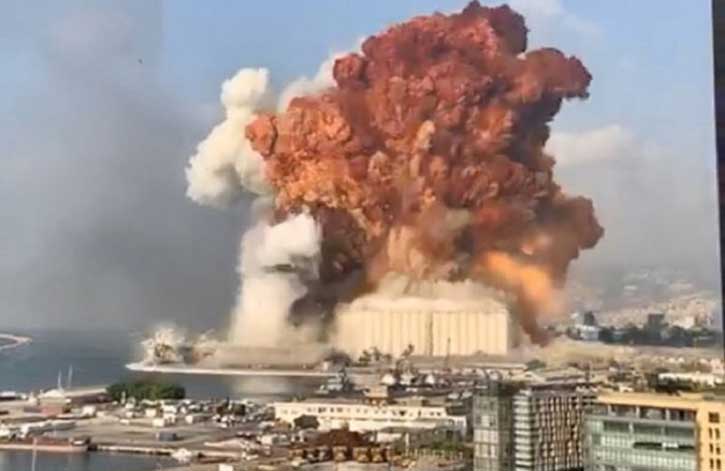On Tuesday, August 4th, an explosion went off in the port of Beirut, Lebanon, that has devasted the city, killing over 178 and injuring over 6,000 people. Rescue workers have been digging through the rubble, attempting to find survivors of the blast that has left 300,000 people temporarily homeless and caused damage upwards of an estimated $15B.
The massive explosion followed a large fire where a warehouse went up in flames. Initially, plumes of smoke were seen coming from the fire, which was then followed by one of two explosions.
About a half a minute later, an enormous second blast sent a mushroom cloud of reddish smoke into the air, and a supersonic blast that ripped through the atmosphere, radiating throughout the city. The source of the explosion? About 2,750 metric tons of Ammonium Nitrate confiscated from a Russian cargo ship in 2014 and stored since near the port docks.

What is Ammonium Nitrate?
Ammonium Nitrate (NH4NO3) is an odorless, crystalline substance that is the result of a reaction between ammonia (NH3) and Nitric Acid (HNO3). Ammonium Nitrate is commonly used as fertilizer in granule form, as it dissolves under moisture allowing Nitrogen to be released into the soil.
For this reason, it plays an essential role as a fertilizer, in farming and agriculture. However, due to its explosive properties, it is also a key ingredient for bulk commercial explosives, often used in both the construction and mining industries. In fact, over the past decade, Ammonium Nitrate has been the cause of numerous accidental industrial explosions across the globe.
How did it happen?
Surprisingly, Ammonium Nitrate is quite difficult to ignite. In its pure form, it is not dangerous, nor is it explosive on its own. However, when energy is applied to it, the molecule is no longer stable. Though not combustible on its own, Ammonium Nitrate is an oxidizer which intensifies combustion, allowing other substances to ignite easily. The substance is heat sensitive and may become explosive if exposed to an explosive mixture, fuel, or fire.
The reddish-orange smoke, suggests the incident was likely an accident
Such is the case as we have seen happen in Beirut. The explosive precursor was exposed to the initial fire, causing a blast that was felt in as far as Syria, Israel, Turkey, some parts of Europe, and was even heard as far as Cyprus over 150 miles away. The event charted a seismic tremor at a magnitude of 3.3 on the Richter scale, a measure of the strength of Earthquakes, as reported by the United States Geological Survey; an event that surely would have been higher had most of the energy not been thrust upwards into the atmosphere rather than into Earth’s core as is the case with major earthquakes.
We know the Ammonium Nitrate played a role in the second, larger explosion due to the red smoke seen in the countless videos surfacing online. When decomposed, Ammonium Nitrate primarily breaks down into several gases: Nitrogen, water vapor, and Oxygen [2 NH4NO3(s)→ 2N2(g)+ 4 H2O(g) + O2(g)]. The rapid release of these gases, and the accelerated expansion of Ammonium Nitrate from solid to gas, is what caused such a tremendous explosion. Other reactions create gases like Nitrogen Dioxide (NO2) and Ammonia (NH3), the former which causes an orange-red smoke, as can be seen, thrust up and into the air immediately following the larger secondary blast in Beirut.
The black smoke and the secondary reddish-orange smoke however represent an incomplete reaction, suggesting the incident was likely an accident and unintentional, as a complete reaction would have displayed black and red, rather than white and red smoke. However, at this stage of course we cannot be certain. But what we can be certain about, where we find a huge mistake with severe consequences, is in the unacceptable storage conditions where Ammonium Nitrate was held in Beirut. Because it is a valuable commodity, the substance is produced by hundreds of manufacturers worldwide – and with that comes regulation.
The Occupational Safety and Health Administration and the Department of Homeland Security, both who regulate the substance, state that any quantity over 1,000 pounds of fertilizer-grade Ammonium Nitrate, must be stored in a building no higher than one-story, must have an ample water supply and nearby fire-hydrants, and sufficient ventilation in case of a fire.
Where else do we see Ammonium Nitrate?
Besides its commercial uses for fertilizer and bulk explosives, Ammonium Nitrate is also the prime ingredient used in Improvised Explosive Devices (IEDs), and homemade explosives often used by the Taliban and many other terrorist groups around the world. Explosives and IEDs must contain a fuel or explosive mixture, and an oxidizer. Ammonium Nitrate is often used with commercial explosives such as RDX or TNT, where a small explosion triggers a reaction for a larger explosion.
Another common example is Ammonium Nitrate Fuel Oil (ANFO), where Ammonium Nitrate serves as the oxidizer, mixed with fuel oil (the fuel source). since its first malicious use in the Sterling Hall Bombing at the University of Madison-Wisconsin in 1970, ANFO has been the source of countless acts of terrorism across the globe (Oklahoma City 1995, Ireland 1972 and 1973, London 1993, Peru 1992, China 2001, Greece 2010, Oslo 2011, etc.).
How do we identify Ammonium Nitrate?
In most cases, Ammonium Nitrate comes in an odorless, solid form of dry ‘prills’ or little round pellet-like spheres formed by melted liquid. In some cases, it may take a crystal form, or a more salt-like granule form when the crystals are crushed. The substance is usually white, although in some cases may appear with a yellowish tint. In less common cases the substance maybe orange or brownish. As the substance is manufactured both legally and illegally around the globe – its appearance may vary. However, to the naked eye, it would often be almost impossible to distinguish the substance from any other dozens of substances that come in a white powder-like form. For this reason, it is important to use reliable technologies for the detection and identification of such hazardous materials.
Laser Detect Systems (LDS) specializes in the detection and identification of hazardous substances such as explosives, narcotics, and precursors. Precursors, like Ammonium Nitrate, are ingredients for explosives or narcotics. Oftentimes on their own, these substances may seem innocent, but when combined with the right materials can be extremely dangerous. Another common example is Potassium Chlorate (KClO3) which is commercially used to make matchsticks light.

In fact, there are dozens of other common precursors that we find in everyday households that can be used to make explosives. For example, due to easy access to its ingredients, TATP (Tri-Acetone, Tri-Peroxide), nicknamed the “Mother of Satan,” is a very deadly explosive that has been used by terrorists in dozens of disastrous bombings worldwide over the past twenty years (London 2005, Paris 2015, Brussel 2016, Manchester 2017, Sri Lanka 2019). Its precursors include Acetone, commonly used as nail polish remover, and highly concentrated Hydrogen Peroxide. At 6% concentration this substance is used as blond hair bleach, and at 9% in a platinum blonde hair bleach; but at over 18% Hydrogen Peroxide is used as an explosive precursor. When mixed with a little bit of acid, lemon juice, for example, the substance crystallizes into TATP, a dangerous and unstable explosive substance that requires a small amount of the substance for a large effect.
LDS utilizes multiple technologies in its various products to detect not only explosives and narcotics but their precursors in all forms: solid, liquid, gas. Furthermore, LDS systems can detect residual traces of these substances invisible to the naked eye – both across surfaces, and airborne in the air surrounding us.

The idea behind detecting and identifying precursors is to develop a preventative strategy and identify these substances on their own before they become an explosive, or immediate threat. Furthermore, with advanced capabilities to sense new substances, detect and identify new materials, LDS systems have the ability to adapt to evolving threats, and grow their known database as the threats grow – an important feature that is critical in today’s day and age where terrorists are connected worldwide, becoming smarter with each day and finding new and innovative ways to produce and conceal explosives.
For more information on LDS, its technologies, and products contact Tom Gilad or visit Laser-Detect.

















